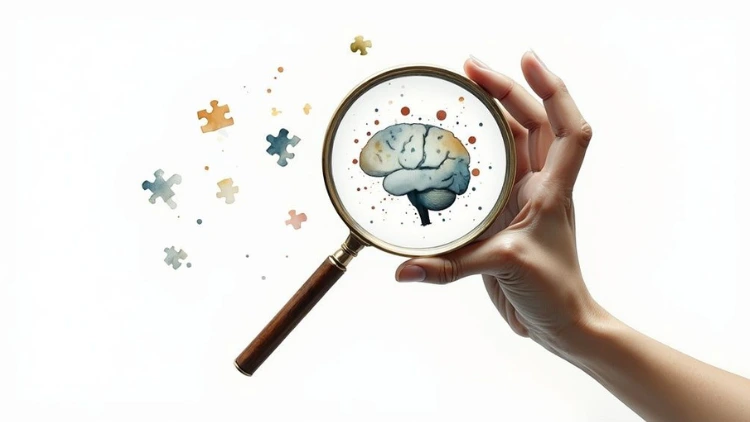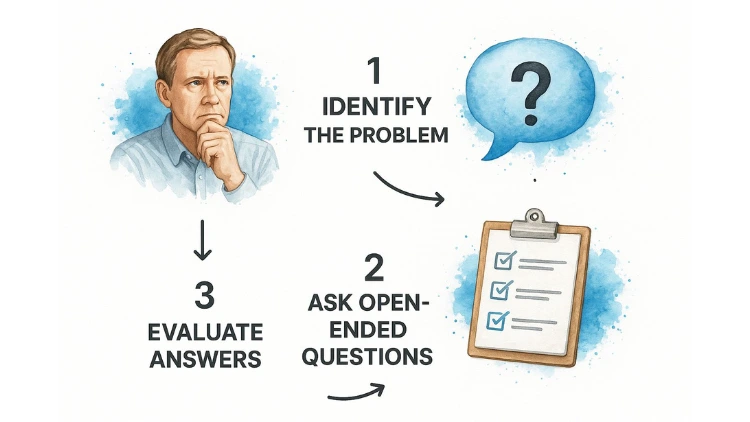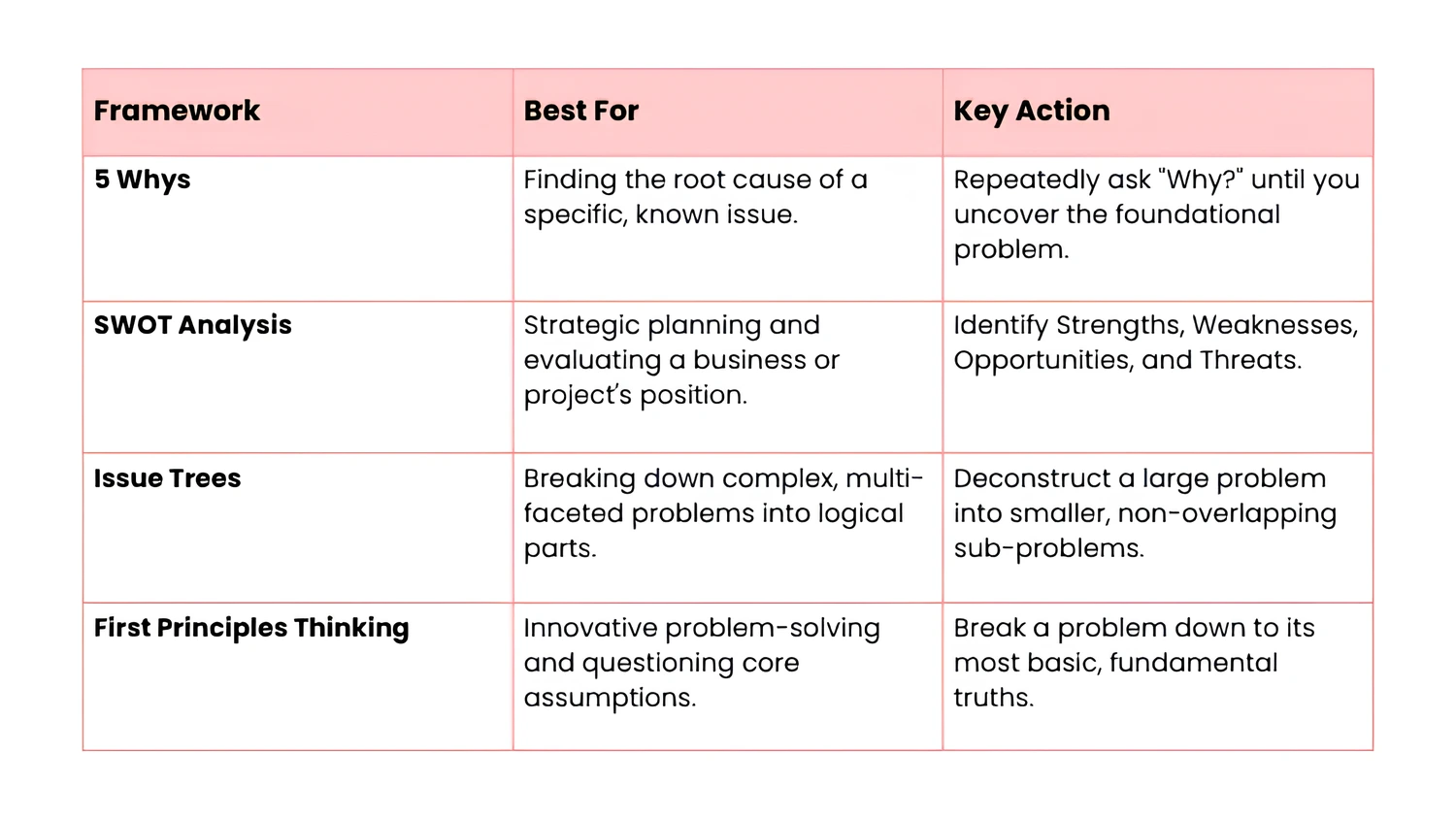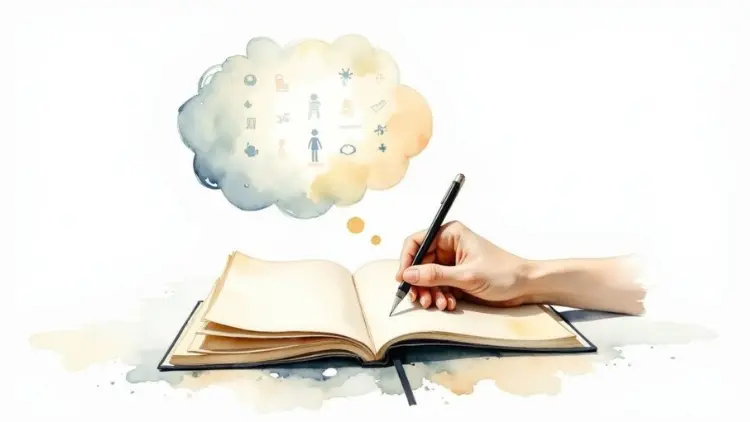How to Improve Critical Thinking Skills

To get better at thinking critically, you have to learn how to systematically break down information, challenge your own deep-seated assumptions, and seriously consider arguments from different angles. It’s a very deliberate process—actively questioning what you read, hear, and believe instead of just passively accepting things as they are.
Jump To Section

Earn As You Learn
Earn 25% commission when your network purchase Uplyrn courses or subscribe to our annual membership. It’s the best thing ever. Next to learning,
of course.
Why Critical Thinking is a Skill You Can't Ignore
Let's be real for a second. The term 'critical thinking' can sound a bit stuffy, like something you’d only hear about in a college lecture. But in the real world, it's the one skill that consistently separates a good decision from a disastrous one.
It’s what helps you spot the spin in a news headline, figure out which career path actually makes sense for you, or finally solve that nagging problem at work that everyone else just complains about.
Developing this kind of mindset isn't about being the smartest person in the room. Far from it. It's about adopting a methodical way of looking at information so you can get past the surface-level noise and see what’s really going on.
From Abstract Idea to Practical Tool
The real magic happens when you start applying critical thinking to actual, everyday challenges.
Think about a manager who sees a project falling behind. The average person might just say, "We need to work faster." But a manager using critical thinking will start asking questions. Are the underlying processes flawed? Is there a weird team dynamic causing friction? Do we have the right people or tools for the job? That’s how you find a permanent solution, not just a temporary patch.
This guide is all about giving you actionable frameworks to build this skill—no vague advice here. The payoff goes way beyond your job:
- Better Decision-Making: You'll learn how to weigh your options more objectively by looking at the actual evidence and thinking through the potential consequences. For example, instead of buying a new car based on a flashy ad, you'd research its safety ratings, long-term maintenance costs, and resale value, leading to a more financially sound choice.
- Increased Problem-Solving Ability: It gives you the tools to break down massive, complicated issues into smaller, more manageable parts so you can come up with a real strategy. An actionable insight here is to take a big goal like "increase sales" and break it down into smaller problems to solve, like "improve website conversion rate" or "generate more qualified leads."
- Enhanced Self-Awareness: You get much better at spotting your own biases and assumptions, which is a massive step in personal growth. For a deeper dive, check out this article on 10 ways to think like a wise person.
Critical thinking is the art of analyzing and evaluating thinking with a view to improving it. It is self-directed, self-disciplined, self-monitored, and self-corrective thinking.
When it comes down to it, mastering this skill means taking back control of your own thought processes. It gives you the confidence to navigate a world that’s only getting more complex, turning big challenges into chances to grow.
Learn to Ask Better Questions
Great critical thinking doesn't come from having all the answers. It starts with asking the right questions.
This is all about shifting your mindset from just being passively curious to actively and intentionally digging for the truth. It's the difference between wondering why something happened and methodically uncovering the real reason it did.
This is a skill most of us were never formally taught. It’s a huge gap, especially when you consider that 94% of people think critical thinking is essential. A 2020 study really highlighted this disconnect, showing just how much we need practical, repeatable questioning techniques in our toolbox.
Go Deeper with Structured Questions
One of the best methods I’ve come across is the Five Whys technique. It's incredibly simple but gets you to the root cause of a problem instead of just putting a bandage on the symptoms.
Let’s say a marketing campaign completely tanks. The surface-level question is obvious: "Why did it fail?" But a critical thinker using the Five Whys would drill down much further.
- Why did the campaign fail? Because the click-through rate was abysmal.
- Why was the rate so low? Because the ad copy didn't connect with our audience.
- Why didn't it connect? Because the messaging was too generic. It didn't speak to a specific pain point.
- Why was the messaging so generic? Because we rushed the research to hit a tight deadline.
- Why was the deadline so tight? Because the initial project planning was totally unrealistic.
Boom. Now you see the real problem isn't just bad ad copy—it's flawed project planning. This is how you move from just pointing out what's wrong to finding an actual solution.
By learning to ask layered questions, you uncover the foundational issues that often hide in plain sight. This transforms you from a problem-spotter into a true problem-solver.
Another fantastic tool is Socratic questioning. This is all about turning the spotlight back on yourself and challenging your own assumptions. Before making your next big decision, stop and ask:
- What am I assuming to be true here?
- What evidence actually supports this belief? What contradicts it?
- Is there a completely different way to look at this situation?
Here's a practical example: Before deciding to switch careers, you might ask, "What am I assuming to be true about this new field?" You might realize you're assuming it will be less stressful, an assumption you should validate with real evidence by talking to people in that industry.
Forcing yourself to answer these questions dismantles your biases and bulletproofs your reasoning. Probing your own logic is a huge part of improving critical thinking, and it ties directly into another vital skill: listening. To ask smarter questions, you first have to get better at hearing the answers. You can learn more about this in this article on the principles of effective listening.
Break Down Complex Problems Effectively
When you’re staring down a complex problem, it’s easy to feel overwhelmed. The path forward seems tangled and unclear, which can lead to either total procrastination or a hasty, flawed decision. The best critical thinkers I know resist that initial panic. Instead, they break the challenge down into smaller, more manageable pieces.
This isn't about finding a quick fix; it's about developing a structured process for thinking clearly. By dissecting a big issue, you can analyze each component individually. This helps you understand how all the parts connect and influence one another, turning a chaotic mess into a series of solvable puzzles.
Visualizing the problem is often the best first step. It helps get the ideas out of your head and into a format you can actually work with.
As you can see, the process isn't complicated. It's about moving from identifying the core issue to deeply evaluating potential answers, which is always a more thoughtful approach.
Turn Chaos Into Clarity
Let's apply this to a real-world scenario. Imagine you're in charge of planning a complex project launch at work. The initial goal—"launch the new product"—is way too big and vague to be useful. Breaking it down is what creates actionable steps.
A great way to start is with mind mapping. This technique is perfect for visually organizing your thoughts as they branch out from the central problem. From your core goal, you could create main branches for key areas like:
- Marketing Strategy: What channels will we use? Who is our target audience? What's the budget?
- Product Development: Are there any lingering bugs? Is the final version truly ready for customers?
- Sales Team Training: Does the team understand the product’s core value proposition and how to sell it?
- Customer Support: Is the support team prepped for common questions and potential issues?
Each of these branches can then be broken down even further into smaller tasks and questions. This method helps you see all the moving parts at once and spot potential roadblocks before they become emergencies. If you want to get better at this, you can declutter your mind using this mind mapping exercise to organize even the most tangled projects.
Different problems call for different tools. While mind mapping is fantastic for brainstorming and seeing connections, other frameworks offer a more linear, structured approach. Choosing the right one depends entirely on the situation you're facing.

Choosing Your Problem-Solving Framework
Here's a quick comparison of a few systematic approaches I've found useful over the years.
Actionable Insight: The next time you feel stuck on a project, grab a whiteboard or notebook. Write the main problem in the center and start drawing branches for every component you can think of. This simple act of creating an Issue Tree or Mind Map can instantly clarify your path forward.
By deconstructing a problem, you move from a state of paralysis to one of empowered action. You’re no longer fighting a giant; you’re simply taking on a series of manageable tasks.
Ultimately, this systematic approach allows you to gather the right data for each piece of the puzzle, analyze your options with greater objectivity, and anticipate outcomes far more accurately. It's a skill that builds on itself, creating a reliable framework you can apply to any challenge that comes your way.

How to Spot Misinformation and Biased Arguments
In a world flooded with content, figuring out what you can actually trust is a core life skill. Strong critical thinking allows you to cut through the noise and separate credible information from everything else. The real challenge is knowing what to look for when a viral post or news article seems convincing on the surface.
One of the most effective tools I've come across for this is the CRAAP test. It's a simple checklist that gives you a solid framework for quickly assessing any source. Think of it as your go-to filter for questionable content.
- Currency: When was this published or last updated? Is the information still relevant or has it become outdated?
- Relevance: How well does this information answer your actual question? Is it on-topic and at the right level for your needs?
- Authority: Who’s behind this? Look at the author, the publisher, or the organization. What makes them qualified to speak on this topic?
- Accuracy: Where is the information coming from? Can you verify it with other reliable sources? Are there any citations or links to back up the claims?
- Purpose: Why does this exist? Is the goal to inform you, to persuade you of something, to sell you a product, or just to entertain?
Let’s apply this. Say you see a social media post pushing a new "miracle cure." Using the CRAAP test, you might notice it has no credible author (Authority), offers zero verifiable data (Accuracy), and is clearly designed to sell a supplement (Purpose). Just like that, you've spotted the red flags. Honing these evaluation skills is a huge part of media literacy, which is an essential skill today.
Unmasking Flawed Reasoning
Beyond just checking the source, true critical thinking means spotting when an argument itself is built on a shaky foundation. This is where a basic understanding of logical fallacies comes into play. These are common errors in reasoning that can make a weak point seem much stronger than it actually is.
For instance, have you ever watched a debate where someone starts attacking their opponent's character instead of addressing their point? That's a classic ad hominem fallacy.
Or what about when someone completely twists their opponent's position to make it easier to knock down? That's known as a straw man argument. A practical example would be if someone argues for stricter car emission standards, and their opponent retorts, "So you want to take away everyone's cars and destroy the economy?" The original point was distorted into an easier-to-attack position.
By learning to identify these common fallacies, you not only protect yourself from manipulation but also learn to build more solid, coherent arguments of your own. You start seeing the structure of arguments, not just the emotional appeals.
Getting good at spotting these flawed techniques in ads, political speeches, and even everyday conversations is a powerful exercise. It trains your brain to zero in on the real substance of a claim, strengthening your ability to think clearly and for yourself.

The Link Between Education and Analytical Skills
We tend to think of formal education as the main training ground for sharpening our analytical abilities. Classrooms, in theory, are where we learn not just what to think, but how to think. But the truth is, the connection between traditional schooling and developing real-world critical thinking isn't always so clear-cut.
While higher education certainly helps, the results can be surprisingly underwhelming. A landmark international study that assessed 120,000 students found that while many did improve their critical thinking, the overall growth was small.
Even more telling? About 50% of graduating students still scored in the two lowest proficiency levels. This suggests a major gap between what's taught in the classroom and the advanced analytical skills needed to thrive out in the real world. If you're curious, you can read the full research about these critical thinking findings and see the data for yourself.
This doesn't mean education is a failure. It just highlights a crucial point: passive learning isn’t enough. Simply absorbing facts and cramming for exams rarely builds the mental muscles required for true analysis. Real growth happens when you’re actively challenged.
Cultivating Your Own Critical Thinking Curriculum
For anyone committed to lifelong learning, the secret is to take charge of your own cognitive development. This is true whether you're in a formal degree program or learning on your own. It means actively seeking out experiences that push you beyond rote memorization and force you to wrestle with new ideas.
You can start by looking for opportunities that demand active participation and deep analysis:
- Debate-Focused Courses: Look for subjects that force you to build and defend a position. Think philosophy, ethics, or even political science.
- Case Study Workshops: Find workshops where you have to dissect real-world business problems or social issues and come up with viable solutions.
- Project-Based Learning: Get involved in projects that require research, problem-solving, and weaving together complex information into a cohesive whole.
Actionable Insight: Don't just read a non-fiction book; actively engage with it. For every chapter, write down the three most compelling points and one question the author didn't fully answer. This transforms passive reading into an active analytical exercise.
The most effective learning environments don't just hand you information; they challenge you to question it, connect it to other ideas, and apply it in new situations. This kind of active engagement is what actually rewires your brain for sharper thinking.
By taking this self-directed approach, you get a better handle on how the brain learns most effectively. It allows you to build a personalized curriculum for your own mind, long after you’ve left the traditional classroom behind.

Putting Critical Thinking into Practice
Knowing the theory behind critical thinking is a great start, but the real magic happens when you start applying it consistently. You have to move the concepts out of the abstract and into your daily habits. This is what builds the mental muscle for sharper reasoning and, ultimately, better choices.
Make no mistake, this transition from theory to application is where the real work begins. It demands a deliberate, conscious effort to question your own thought processes, even—and especially—when it feels uncomfortable.
Building Your Critical Thinking Toolkit
To get started, let's focus on a few key habits you can build right now. These aren't complicated academic exercises; they are simple, repeatable actions designed to sharpen your mind over time.
One of the most powerful tools you can adopt is a decision journal. It's exactly what it sounds like: a log where you document important decisions you're facing. For each one, take a few minutes to write down the situation, the options you’re weighing, why you landed on your final choice, and what you expect the outcome to be.
Here's a practical example: If you're deciding whether to accept a new job offer, you'd log the salary, benefits, your gut feelings, and your prediction ("I expect to be less stressed and more fulfilled"). Then, the crucial part: revisit these entries a month or two down the line. Compare what actually happened to what you predicted. This simple act of review is incredibly revealing. It shines a light on flaws in your reasoning, uncovers biases you never knew you had, and gives you invaluable feedback on your own judgment.
Another essential habit is to actively practice intellectual humility. This just means seeking out viewpoints that challenge your own.
- Follow Opposing Views: Intentionally read articles or listen to podcasts from people and sources you normally disagree with.
- Ask "How Could I Be Wrong?": Before digging your heels in on a strong opinion, genuinely ask yourself this question. Try to build the strongest possible case against your own position.
- Listen to Understand, Not to Respond: When you’re in a discussion, shift your focus. Concentrate on fully grasping the other person's perspective before you even start thinking about your comeback.
Integrating these habits isn't just about winning arguments or trying to make flawless decisions. It's about developing a more flexible, honest, and effective way of thinking that serves you in every single corner of your professional and personal life.
This systematic approach is what turns critical thinking from a passive concept into an active, everyday skill. You stop just knowing what to do and start actually doing it, building a solid foundation for making smarter, more considered choices.
Still Have Questions About Critical Thinking?
Even with a solid game plan, a few questions always seem to pop up when people start seriously working on their critical thinking skills. It's totally normal. Let's walk through a couple of the most common ones I hear, so you can move forward with confidence.
Can I Really Get Better at Critical Thinking as an Adult?
Yes, absolutely. This is a big one, and the answer is a resounding yes. Think of critical thinking less as a fixed trait you were born with and more like a muscle. The more you work it out with consistent, deliberate practice, the stronger it gets.
Our brains are thankfully quite adaptable, even as we get older. This means you can always forge new mental habits and pathways. The key is to challenge yourself with new, complex activities.
- Pick up a complex new skill: Trying to learn something like coding, a musical instrument, or even a new language forces your brain to build new connections and think in highly structured ways. For example, learning chess teaches you to anticipate future moves and evaluate multiple outcomes simultaneously—a core critical thinking skill.
- Join a debate or discussion group: This is like a real-time workout for your brain. You have to analyze arguments on the fly, clearly state your own reasoning, and genuinely consider opposing views.
What's the Single Biggest Thing Holding Me Back?
If I had to pick just one, it would be our own cognitive biases. These are the sneaky mental shortcuts our brains take to make decisions faster, but they often trip us up and lead to some seriously flawed reasoning.
The most dangerous of these is confirmation bias. It's our natural instinct to look for, favor, and remember information that lines up with what we already believe. It's like building an echo chamber inside your own head, making it incredibly difficult to look at new evidence with an open mind.
Ever notice how, when you're excited about a potential investment, you seem to only find articles that praise it? You might be unconsciously scrolling right past the ones detailing its risks. An actionable insight to combat this is to actively search for disconfirming evidence. Before making a big purchase, spend 10 minutes searching for negative reviews or reasons not to buy it. This forces a more balanced perspective. Just becoming aware that your brain does this is the most important first step to overcoming it.
Ready to build the skills that matter? Uplyrn offers a wide range of courses designed by industry experts to sharpen your analytical abilities and problem-solving skills. Explore our courses and start your journey today.


Leave your thoughts here...
All Comments
Reply